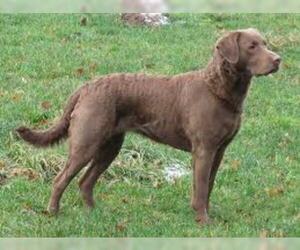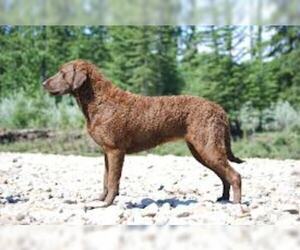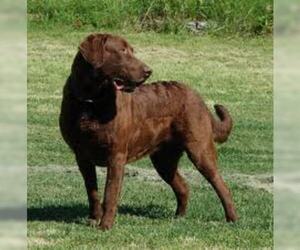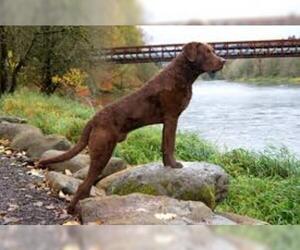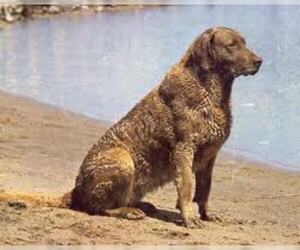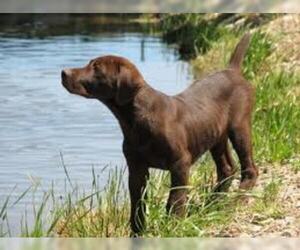
All about Chesapeake Bay Retriever dog breed
A.K.A. :Chessie, CBR, Chesapeake, Cheasapeake, Chesapeake Bay Dog, Retriever, Chesapeake Bay Duck Retriever, Duck Retriever, Bay Retriever, Retriever Bay, Bay Dog, American Duck Retriever, Chesapeake Duck Dog
Size
Grooming requirements
Exercise requirements
Good with other dogs
Watchdog ability
Energetic
Training requirements
Playful
Affectionate
Good with other pets
Good with children
Good with strangers
Winter
Summer
Healthiness
Protective
Life Span
| Pure Breeds | Member |
| Breeds A - Z | C |
| Breeds by Group | Gun Dog Sporting |
| Breeds by Trait | High Stamina Dog Breeds Smartest Dog Breeds |
| Overview: | The Chesapeake Bay Retriever, often affectionately called a "Chessie," is a robust and intelligent breed originating from the Chesapeake Bay area of the United States in the 19th century. Bred specifically for retrieving waterfowl in harsh, icy conditions, they possess a distinctive dense, oily, and wavy coat that provides excellent insulation. Physically, they are powerful dogs with a broad head, strong jaws, and a characteristic otter-like tail, typically weighing between 55-80 pounds. Their temperament is known for being courageous, affectionate, and protective of their families, though they can be reserved with strangers. While generally good with children and active families, their high energy levels and need for consistent training mean they are not well-suited for apartment living and thrive with ample outdoor space. Regarding health, Chessies are generally hardy but can be prone to certain conditions like hip and elbow dysplasia, progressive retinal atrophy, and sometimes bloat, making responsible breeding and regular vet check-ups important for their well-being. |
F.A.Q.
All You Need to Know About the Chesapeake Bay Retriever Breed
The Chesapeake Bay Retriever, or "Chessie," is a robust, intelligent, and highly active American breed originating from the Chesapeake Bay region, where it was developed as a powerful waterfowl retriever. Known for their cheerful disposition and exceptional swimming ability, Chessies are fiercely loyal to their families, often displaying a protective nature. Physically, they boast a distinctive oily, dense double coat (ranging in shades of brown, sedge, or deadgrass) that repels water, along with strong, muscular builds. While generally good with children and other pets when properly socialized, their high energy and independent streak make them best suited for active families and houses with yards, not apartment living. They require significant daily exercise, including swimming or vigorous play, and moderate grooming to maintain their unique coat. Potential owners should be aware of common health concerns like hip and elbow dysplasia, and eye conditions, ensuring regular veterinary check-ups for these resilient dogs.The average weight for a Chesapeake Bay Retriever is between 55-80 pounds. A healthy weight for Chesapeake Bay Retriever males typically ranges from 65-80 pounds, while females are usually 55-70 pounds. This makes them a medium-to-large sized breed with a robust build.
Chesapeake Bay Retriever Height: How Tall is a Chessie?
If you're wondering about the average height of a Chesapeake Bay Retriever, you've come to the right place! These powerful and athletic dogs have a well-defined size range that's important to consider when evaluating their overall build.On average, an adult Chesapeake Bay Retriever typically stands between 21 to 26 inches tall at the shoulder (also known as the withers). This measurement provides a good indication of their general stature.It's worth noting that there is a slight variation based on gender:- Males: Generally stand between 23 to 26 inches at the shoulder.
- Females: Typically measure between 21 to 24 inches at the shoulder.
The Chesapeake Bay Retriever breed is officially recognized by the AKC in three primary colors, all within the brown spectrum: brown, sedge, and deadgrass. These AKC recognized Chesapeake Bay Retriever colors are a range of shades, from a light tan or straw color (deadgrass) to a rich, deep brown. Rare Chesapeake Bay Retriever colors or exotic Chesapeake Bay Retriever variations such as black, cream, or other dilute colors like blue or lilac, and patterns like merle, are not accepted by major kennel clubs like the AKC and are considered disqualifying faults in the show ring. When looking for a Chesapeake Bay Retriever, expect to find these beautiful shades of brown, sedge, and deadgrass, which are characteristic of the breed's working heritage and provide excellent camouflage. Prices for these standard colors generally reflect the breeder's reputation and lineage. Variations outside the accepted brown spectrum may indicate a mixed breed or a non-standard genetic expression.
The Chesapeake Bay Retriever personality is renowned for its courage, cheerfulness, and intelligent nature. This breed is fiercely loyal to its family, often forming a strong bond with one primary caregiver, though affectionate with all household members. While generally friendly with familiar faces, they can be reserved or discerning with strangers, making early sociability and exposure crucial.Their temperament of Chesapeake Bay Retriever is characterized by an active and enthusiastic disposition, requiring significant physical and mental stimulation to thrive. They are highly adaptable to various living situations given sufficient exercise but are not typically suited for apartment living due to their energy levels and need for space.With children, well-socialized Chesapeakes can be wonderful companions, often displaying a patient and protective instinct, though supervision is always recommended, especially with very young children due to their size and playful vigor. Regarding other pets, they can coexist peacefully, particularly if raised together, but their strong prey drive might require careful introductions and ongoing management with smaller animals. This breed excels in active households that can meet their considerable exercise and training needs, providing a devoted and engaging companion.
The Chesapeake Bay Retriever temperament is generally described as affectionate, intelligent, and courageous. They are renowned for their loyalty and devotion to their families, making them excellent companion dogs. While generally not overly friendly with strangers, they are attentive and protective, possessing a strong "watchdog" instinct. Early and consistent socialization is crucial to ensure they are well-adjusted and sociable with new people and experiences.Chesapeakes typically do well with children they are raised with, often displaying a patient and tolerant demeanor. However, their size and energy mean supervision is always recommended, especially with very young children. Their behavior with other pets can vary; they can coexist peacefully with cats and other dogs if introduced and socialized properly from a young age, but their strong prey drive might make them unsuitable for homes with smaller, unsupervised pets.They are highly intelligent and eager to please their owners but can also display a degree of stubbornness, especially if they don't see the point in a command. This requires a confident, consistent, and positive training approach. They are not overly sensitive in the same way some breeds are, but they respond best to fair and respectful handling, rather than harsh methods.Adaptability to apartment living is generally low. Chesapeakes are energetic dogs that thrive with ample outdoor space and a family committed to providing significant daily exercise and mental stimulation. They are happiest with a job to do, whether it's retrieving, swimming, or long hikes. Without sufficient activity, they can become bored and destructive. They are truly an outdoor-loving breed that excels in active households.
Chesapeake Bay Retriever Care: Daily Maintenance & Health TipsChesapeake Bay Retriever care is moderate but consistent. Grooming needs are minimal; their harsh, oily double coat requires brushing 1-2 times weekly to remove loose hair and distribute natural oils, more during shedding season. Bathing should be infrequent to preserve coat oils. Chesapeake Bay Retrievers are not a low-energy dog breed; they require substantial daily exercise – at least an hour of vigorous activity like swimming, running, or fetching to prevent boredom and destructive behaviors. Mental stimulation through training and puzzle toys is also crucial. Dietary considerations involve a high-quality kibble appropriate for active, large breeds, portion-controlled to prevent obesity. Unlike some breeds, Chesapeake Bay Retrievers do not have brachycephalic anatomy; therefore, specific wrinkle or ear cleaning related to folds is not typically required. However, regular ear checks are essential, especially for swimming dogs, to prevent infections.Common health concerns for Chesapeake Bay Retrievers include hip and elbow dysplasia, progressive retinal atrophy, and sometimes bloat. Skin issues are rare but can occur with improper diet or allergies. Dental care is vital; brush teeth several times a week to prevent plaque buildup and gum disease. Weight management is key to preventing joint problems and other health issues. How to care for a Chesapeake Bay Retriever effectively involves providing consistent training, early socialization, and regular vet check-ups. They are generally resilient dogs, but a balanced approach to exercise, nutrition, and preventive care ensures a long, healthy life.
The Chesapeake Bay Retriever activity level is high, making them an excellent fit for active families. These intelligent and robust dogs possess a unique balance of intense, short bursts of energy followed by long periods of rest, especially when given adequate exercise.Typically, a Chesapeake Bay Retriever requires a minimum of 60-90 minutes of vigorous daily exercise. This isn't just a leisurely walk; they thrive on activities like swimming, retrieving (especially in water), long runs, hiking, and engaging in dog sports such as agility or dock diving. Their love for water and natural retrieving instincts mean they absolutely adore playtime involving fetches with bumpers or balls, particularly near lakes or ponds.While incredibly athletic, it's crucial to be aware of the limitations due to their brachycephalic (short-nosed) anatomy. Despite not being as exaggerated as some other brachycephalic breeds, Chessies can be prone to overheating, especially in hot or humid weather, or during intense exercise. Therefore, exercise needs should always be met with caution, avoiding peak heat hours and ensuring plenty of water and opportunities to cool down.How active are Chesapeake Bay Retrievers? They are very active and need a family committed to providing consistent physical and mental stimulation. They are definitely not suitable for low-energy households or apartment living without significant dedication to their daily exercise requirements. Without sufficient outlets for their energy, they can become bored, destructive, or develop behavioral issues. They thrive when they have a job to do and ample space to move.
Breed Breakdown: What Experts Say About the Chesapeake Bay Retriever
I'd rate the "Size" trait of the Chesapeake Bay Retriever a 7.This rating places them firmly in the "large" category, though not "very large" like a Great Dane. Chesapeake Bay Retrievers are robust, powerfully built dogs. Males typically stand 23-26 inches at the shoulder and weigh 65-80 pounds, while females are slightly smaller at 21-24 inches and 55-70 pounds. Their dense, muscular build and substantial bone structure contribute to their overall large presence. Compared to many companion breeds, such as a Cavalier King Charles Spaniel or even a Golden Retriever, they are noticeably larger and more substantial.Due to their size and energetic nature, Chesapeake Bay Retrievers are not ideally suited for apartment living. They thrive in homes with ample space, preferably a securely fenced yard, where they can expend their considerable energy. Their size can also make travel challenging, requiring a large vehicle and specific accommodations. Households with space constraints would likely find a Chessie's size and activity level overwhelming. They are best suited for owners who understand and can accommodate a large, active working breed.
I would rate the Chesapeake Bay Retriever's grooming requirements as a 3.Chesapeake Bay Retrievers are relatively low-maintenance in the grooming department, especially when compared to many other companion breeds. Their defining feature is their short, dense, harsh outer coat with a fine, woolly undercoat, which is naturally oily and water-resistant. This coat is designed for their work in cold water, meaning it doesn't mat easily and requires minimal brushing – typically once a week with a slicker brush or rubber curry mitt to remove loose hair and stimulate the skin. While they do shed, it's generally a moderate amount and predictable, often more pronounced seasonally. They don't have significant skin folds that require special attention, and their ears, while needing regular checks and cleaning like any dog to prevent infections, aren't particularly prone to issues. Nail trimming should be done every few weeks as needed, which is standard for most dogs. Bathing is only necessary when they are visibly dirty or smelly, as frequent bathing can strip their coat of its natural oils, which are crucial for its water-repellent properties. They are not particularly known for a high susceptibility to skin issues or allergies compared to many breeds with more complex coats or skin sensitivities. Their grooming is straightforward and doesn't involve intricate styling, frequent professional trims, or specialized products, making them an easy-care breed in terms of upkeep.
I would rate the Chesapeake Bay Retriever's "Exercise Requirements" a 9 out of 10.Chesapeake Bay Retrievers possess an exceptionally high level of physical endurance and energy. They were bred for rigorous, all-day work in challenging conditions, which translates into a strong need for sustained movement and mental engagement. Daily activity recommendations for a Chessie are significant, typically involving a minimum of 1-2 hours of vigorous exercise. This isn't just a leisurely walk; they thrive on activities like running, swimming (which they excel at and adore), fetching, and challenging hikes. Their tolerance for sustained movement is very high, and they can keep going long after many other breeds would tire. Unlike some breeds, they do not have any respiratory limitations due to brachycephalic anatomy, allowing them to engage in intense physical activity without undue strain. They are highly suitable for various types of exercise, from long, brisk walks and extended play sessions to demanding agility courses and dock diving. While they enjoy downtime with their families, a Chessie absolutely requires structured routines and substantial physical activity to stay healthy, mentally stimulated, and prevent behavioral issues that can arise from boredom and pent-up energy. They are not a breed that thrives with minimal activity; rather, they demand consistent and challenging exercise to be their best.
I would rate the Chesapeake Bay Retriever's "Watchdog Ability" at a 7 out of 10.Chesapeake Bay Retrievers are known for being quite discerning and possess a natural wariness towards strangers. They are generally very alert to their surroundings, and their strong protective instincts for their family and property often manifest as a deep, resonant bark when unfamiliar sounds or people approach. They are not typically prone to excessive, indiscriminate barking, but they will certainly sound the alarm when they perceive something out of the ordinary. While not aggressive in the same way a dedicated guard dog might be, their size, imposing presence, and willingness to stand their ground can act as a significant deterrent to potential intruders. They are more than capable of providing meaningful early warnings in a home environment and their protective nature goes beyond just being a passive companion, making them effective at alerting their owners to potential threats.
I would rate the Chesapeake Bay Retriever's "Good with Other Dogs" trait as a 4 out of 10.While not inherently aggressive, the Chessie typically exhibits a strong independent streak and a tendency towards dominance, especially with other dogs of the same sex. They are often aloof or indifferent to unfamiliar dogs and can be assertive in their interactions. Their prey drive, while primarily directed at game, can sometimes manifest as an overly intense interest in smaller, faster dogs, which might be misinterpreted as aggression or lead to scuffles if not managed. While some well-socialized Chessies can coexist peacefully in multi-dog households, particularly with carefully chosen companions of a different sex and temperament, they generally require significant and consistent socialization from a young age to develop even a moderate level of tolerance. Without this, they are more likely to demand respect and can be prone to establishing a hierarchy, sometimes leading to tension or conflict. They are not a breed that universally thrives in canine company without careful introductions, ongoing supervision, and firm, fair training to ensure peaceful coexistence. They are generally not the "play-with-any-dog" type, and their interactions often require careful management and understanding of their nuanced social cues.
I would rate the Chesapeake Bay Retriever's "Energetic" trait as a 9 out of 10.Chesapeake Bay Retrievers are renowned for their incredibly high energy levels and working drive. They are a naturally active breed, far from laid-back, and thrive on consistent physical and mental stimulation. Their endurance is exceptional, allowing them to participate in long sessions of retrieving, swimming, and various dog sports. They are incredibly playful and require significant outlets for their energy to prevent boredom and potential destructive behaviors. Their muscular build and boundless enthusiasm make them ideal companions for outdoor and athletic activities like hiking, hunting, competitive obedience, agility, and dock diving. Unlike many companion dogs, a "walk around the block" simply won't suffice for a Chessie; they need vigorous exercise to be truly content. It's important to note that the Chesapeake Bay Retriever is *not* a brachycephalic breed; they possess a moderate, strong muzzle, which contributes significantly to their excellent stamina and exercise tolerance, allowing them to breathe efficiently even during strenuous activity, a stark contrast to breeds with shortened snouts.
I'd rate the Chesapeake Bay Retriever's "Training Requirements" a 7 out of 10.While highly intelligent and eager to please a respected handler, Chessies are also known for their strong will and independent streak, which can manifest as stubbornness. Their attention span, especially as puppies, can be fleeting, and they're not typically the type of dog to simply "obey" without understanding the purpose or receiving consistent, fair, and firm guidance. Responsiveness to commands requires a strong, established bond and clear communication; they won't typically respond to casual suggestions. Consistency is absolutely paramount; any deviation in rules or expectations will be keenly noted and exploited. Positive reinforcement, particularly with high-value treats and praise, is highly effective, but it must be paired with clear boundaries and consequences for undesirable behavior. This breed is generally not beginner-friendly and thrives under experienced handling that can provide a structured routine, consistent training, and firm, fair leadership from a young age. Without proper socialization and consistent training, a Chessie can be a handful, requiring someone who understands the nuanced approach needed to harness their intelligence and drive.
I'd rate the Chesapeake Bay Retriever's "Playful" trait a 7 out of 10.While Chessies are known for their strong work ethic and serious demeanor in the field, they are far from inactive or dull in their home life. They possess a robust, enthusiastic energy and a definite love for games, especially those involving retrieving. Their typical activity level is quite high; they thrive on exercise and mental stimulation, often initiating play with their owners. They respond to toys and playtime with great gusto, particularly if it involves a ball or a dummy they can retrieve. This isn't necessarily attention-seeking in a "lap dog" way, but more a desire for interactive engagement. Compared to some other companion dogs, they are naturally spirited and require an owner who appreciates and can channel that lively energy. However, they aren't quite the relentlessly goofy or overtly playful breed like a Golden Retriever, preferring purpose-driven play over aimless romping. They can also have a more independent streak, so their playfulness is often expressed in bursts of enthusiastic activity rather than constant, in-your-face demands for entertainment.
I would rate the Chesapeake Bay Retriever's "Affectionate" trait a 6 out of 10.While Chessies are undeniably loyal and deeply devoted to their families, they express their affection in a more reserved and independent manner compared to many other companion breeds. They form strong bonds and are typically very sensitive to their owner's emotions, offering quiet support rather than effusive displays. They do desire human companionship and will often follow their family members around, staying close without being overly demanding. However, they aren't generally known for being lap dogs or seeking constant physical closeness like cuddling. Their affection is a deep, abiding loyalty and a quiet presence, rather than a gushy, people-oriented need for constant attention. They thrive on having a purpose and being part of the family unit, but are content with a bit more personal space than some more overtly affectionate breeds.
I would rate the Chesapeake Bay Retriever's "Good with Other Pets" trait a 5 out of 10.While not inherently aggressive, the Chessie's strong prey drive, bred for retrieving waterfowl, means they are not naturally the most pet-friendly breed, especially with smaller, fast-moving animals like cats or rabbits. They can coexist peacefully with other dogs, particularly if raised with them from a young age and properly socialized. However, their assertive nature and potential for resource guarding (especially food or toys) can lead to conflicts, requiring consistent training and supervision to ensure a harmonious multi-pet household. Early and extensive socialization is crucial for them to learn appropriate behavior around other animals, as they are not naturally sociable in this regard and require careful management to prevent their instincts from dominating.
The Chesapeake Bay Retriever, while a magnificent and loyal breed, receives a 6/10 for its "Good with Children" trait. While generally good-natured and possessing a playful streak, especially as a puppy, the Chessie's strong personality and working dog instincts mean they are not inherently the most gentle or patient with very young, boisterous children. They have a high pain tolerance but can be sensitive to rough handling or excessive noise, and their size and power could inadvertently overwhelm small kids.With proper socialization from a young age and consistent training, a Chesapeake Bay Retriever can be a wonderful companion for older, respectful children who understand how to interact with a dog. They are intelligent and eager to please their families, and will often form strong bonds. However, they are not a "set it and forget it" breed when it comes to kids. Constant supervision is crucial with younger children, and parents should be prepared to actively manage interactions and ensure both dog and child are taught appropriate boundaries. They are more likely to thrive in a family that can provide plenty of exercise and mental stimulation, which can help channel their energy and prevent potential frustration that might manifest around children. For families seeking an exceptionally child-friendly breed requiring minimal oversight, the Chessie might require too much dedicated effort.
I would rate the Chesapeake Bay Retriever's "Good with Strangers" trait as a 3.Chesapeake Bay Retrievers are naturally quite reserved and protective, not typically displaying the outgoing, tail-wagging enthusiasm for unfamiliar adults that some other retriever breeds are known for. While not inherently unfriendly, they are often aloof and watchful around strangers, preferring to observe rather than immediately engage. They possess a strong guarding instinct and are quick to alert their families to perceived threats, which can manifest as barking or a watchful, distant demeanor with new people. Early and consistent socialization is absolutely crucial for a Chessie to be comfortable, rather than just tolerant, in public or guest-filled environments. Without proper training and exposure, they can be quite wary and standoffish, requiring a significant amount of time and effort to accept new individuals into their sphere. They are certainly not a breed that is naturally sociable and welcoming with everyone they meet; their trust must be earned.
I would rate the Chesapeake Bay Retriever's "Winter" tolerance at a 9.Chesapeake Bay Retrievers possess excellent cold-weather resilience, stemming from their dense, oily double coat that provides a natural waterproof and insulating layer. Their well-muscled and substantial build, combined with a healthy amount of body fat, further contributes to their ability to maintain core body temperature. Being a large breed, they have a smaller surface area to volume ratio compared to smaller dogs, which helps in heat retention. Crucially, they are not brachycephalic, meaning their respiratory system is not compromised in cold air, reducing the risk of respiratory issues or discomfort often seen in flat-faced breeds. These factors significantly lower their risk of hypothermia during typical winter conditions. They are genuinely bred for retrieving in icy waters, making them perfectly suited for active outdoor enjoyment in cold climates. While individual dogs may vary, and extreme, prolonged exposure without shelter is never advised for any animal, a healthy Chessie generally does not require special winter care beyond what would be considered responsible for any companion dog – adequate food, water, and a warm, dry place to rest. They are far more tolerant of cold than many other breeds and thrive on outdoor activity even when temperatures drop.
I'd rate the Chesapeake Bay Retriever's "Summer" tolerance at a 6.While not brachycephalic, which is a major advantage in heat tolerance, their dense double coat, originally bred to withstand icy waters, can be a significant disadvantage in high temperatures. They possess a robust ability to regulate body temperature through panting, but the thick undercoat can trap heat and limit effective cooling. This places them at a moderate risk of heatstroke, particularly during strenuous activity or prolonged exposure to direct sun. Recommended outdoor activity levels should be significantly curtailed during peak summer heat, especially in humid climates, limiting activities to cooler morning or evening hours. They definitely require special care in summer months compared to many other companion dogs, particularly those with single coats or less dense fur. While they don't necessarily need constant climate control indoors, access to air conditioning or a cool, shaded environment with plenty of fresh water is essential, and close monitoring for signs of overheating is always recommended.
I would rate the Chesapeake Bay Retriever's "Healthiness" trait as an 8 out of 10. This breed is generally considered very robust and resilient, often outliving many other large breeds with a life expectancy typically ranging from 10 to 13 years, and sometimes even longer. They are not prone to the severe breathing difficulties seen in brachycephalic breeds, nor do they commonly suffer from the widespread skin allergies that plague some other sporting dogs. While they can be predisposed to certain genetic conditions, notably hip and elbow dysplasia and sometimes progressive retinal atrophy (PRA), these issues are often managed and significantly reduced through responsible breeding practices. Dedicated breeders diligently screen their dogs, contributing to the breed's overall health and the lower incidence of these problems in well-bred individuals. They are not considered high-maintenance in terms of needing constant veterinary intervention for chronic health issues. With proper nutrition, exercise, and regular preventive care, including routine vet check-ups and vaccinations, a Chessie is likely to lead a very healthy and active life, making them a generally healthy and hardy companion.
I would rate the Chesapeake Bay Retriever's "Protective" trait at a 7 out of 10.Chesapeakes are renowned for their loyalty to their families and possess a strong sense of responsibility. Their innate alertness and intelligence make them excellent watchdogs; they are quick to notice anything unusual in their environment and will often bark to signal a perceived threat. They do have territorial instincts, especially within their home and around their loved ones. While they are not inherently aggressive, their powerful build and imposing presence, combined with a watchful nature, can be a deterrent to strangers. They tend to be reserved and watchful with unfamiliar people, preferring to observe before engaging, and will stand their ground if they perceive a threat to their family. This makes them capable of offering meaningful protection in a household setting, particularly as a deterrent and a vocal alarm system. However, they are also deeply devoted companions and not typically bred to be solely guard dogs. Their protective instincts stem from their loyalty and alertness rather than an inherent desire for confrontation, distinguishing them from breeds specifically developed for protection work. They are more of a companion dog with strong protective capabilities rather than a pure guard dog, but their willingness to defend their family is undeniable.
I would rate the Chesapeake Bay Retriever's "Life Span" trait a 7 out of 10.Chesapeake Bay Retrievers are generally considered to have an average to slightly above-average lifespan compared to other companion dogs. Their typical life expectancy ranges from 10 to 13 years, with many living happily into their early teens. While they are prone to some health issues like hip and elbow dysplasia, progressive retinal atrophy, and sometimes bloat, these are often manageable with responsible breeding practices, proper veterinary care, and a healthy lifestyle. They don't have an exceptionally short lifespan, nor are they known for extreme longevity, placing them firmly in the healthy middle to upper-middle range for most dog breeds.
Chesapeake Bay Retriever Dogs for adoptionSee all dogs for adoption
Chesapeake Bay Retriever BreedersSee all breeders
Similar Dog Breeds for Chesapeake Bay Retriever
Breed Mixes of Chesapeake Bay Retriever
Quick Breed Selector 0 - not important, 1 - smallest, 10 - largest
Variants & Mistakes :Cheasapeake Bay Retriever, Chessapeake Bay Retriever, Chesapeak Bay Retriever, Chesapeke Bay Retriever, Chesapake Bay Retriever, Chesepeake Bay Retriever, Cheasepeak Bay Retriever, Chesapeake Bae Retriever, Chesapeake Bay Retreiver, Chesapeake Bay Retriver, Chesapeak Bay Retreiver, Cheasapeake Bay Retreiver, Chesapeke Bay Retreiver, Chesapeake Bay Reitriever, Chesapeake Bay Retreever, Chesapeke Bay Retriver, Chesapeake Bay Retrievee, Chesapeak Bay Retrievers, Chesapeake Bay Retrieber, Chesapeake Bay Retrieveer, Chessie Bay Retriever, Cheasapeake Bay Retrieve, Chesapeke Bay Retrieve, Chesapeak Bay Retrieve, Chesapeake Bay Retriecer, Chesapeake Bay Retrieverr, Chesapeake Bay Retriievr, Chesapeak Bay Retriver, Chessapeake Bay Retriver, Chesapeake Bay Retriwver, Chesapeake Bay Retrieverv, Chesapeack Bay Retriever, Chesapeake Bay Retriverr, Chesapeake Bay Retrievr, Chessapeake Bay Retreiver, Chessapeak Bay Retriever, Chesepeak Bay Retriever, Chessapeke Bay Retriever, Chesapeake Bay Retrivers, Chessie Retriever, Chessy Bay Retriever, Chesapeke Retriever, Chesapeake Retreiver
